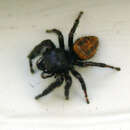en
names in breadcrumbs


Phidippus is a genus in the family Salticidae (jumping spiders).[1] Some of the largest jumping spiders inhabit this genus, and many species are characterized by their brilliant, iridescent green chelicerae. Phidippus is distributed almost exclusively in North America, with the exception of two exported species (Phidippus audax and Phidippus regius).[2] As of January 2021, there were about 80 described species in the genus.[1] Species previously described in Phidippus which are found in India and Bangladesh do not belong in this genus.[2]
The genus name is likely derived from Cicero's speech Pro Rege Deiotaro (Speech in Behalf of King Deiotarus): Phidippus was a slave who was physician to King Deiotaros.[3] Literally, the word means "one who spares horses" in Ancient Greek.[4]
The name for the jumping spider family, Salticidae, also comes from the verb "to jump" in Latin.
As of January 2021, the World Spider Catalog accepted the following species:[1]
In addition to the species above, several species have been misplaced in the genus (according to Edwards' revision) but have yet to be transferred to other genera.[2] These include:
Phidippus is a genus in the family Salticidae (jumping spiders). Some of the largest jumping spiders inhabit this genus, and many species are characterized by their brilliant, iridescent green chelicerae. Phidippus is distributed almost exclusively in North America, with the exception of two exported species (Phidippus audax and Phidippus regius). As of January 2021, there were about 80 described species in the genus. Species previously described in Phidippus which are found in India and Bangladesh do not belong in this genus.